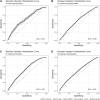Risk Factors for Thyroid Dysfunction in Pregnancy: An Individual Participant Data Meta-Analysis
- PMID: 38546971
- PMCID: PMC11971561
- DOI: 10.1089/thy.2023.0646
Risk Factors for Thyroid Dysfunction in Pregnancy: An Individual Participant Data Meta-Analysis
Abstract
Background: International guidelines recommend targeted screening to identify gestational thyroid dysfunction. However, currently used risk factors have questionable discriminative ability. We quantified the risk for thyroid function test abnormalities for a subset of risk factors currently used in international guidelines. Methods: We included prospective cohort studies with data on gestational maternal thyroid function and potential risk factors (maternal age, body mass index [BMI], parity, smoking status, pregnancy through in vitro fertilization, twin pregnancy, gestational age, maternal education, and thyroid peroxidase antibody [TPOAb] or thyroglobulin antibody [TgAb] positivity). Exclusion criteria were pre-existing thyroid disease and use of thyroid interfering medication. We analyzed individual participant data using mixed-effects regression models. Primary outcomes were overt and subclinical hypothyroidism and a treatment indication (defined as overt hypothyroidism, subclinical hypothyroidism with thyrotropin >10 mU/L, or subclinical hypothyroidism with TPOAb positivity). Results: The study population comprised 65,559 participants in 25 cohorts. The screening rate in cohorts using risk factors currently recommended (age >30 years, parity ≥2, BMI ≥40) was 58%, with a detection rate for overt and subclinical hypothyroidism of 59%. The absolute risk for overt or subclinical hypothyroidism varied <2% over the full range of age and BMI and for any parity. Receiver operating characteristic curves, fitted using maternal age, BMI, smoking status, parity, and gestational age at blood sampling as explanatory variables, yielded areas under the curve ranging from 0.58 to 0.63 for the primary outcomes. TPOAbs/TgAbs positivity was associated with overt hypothyroidism (approximate risk for antibody negativity 0.1%, isolated TgAb positivity 2.4%, isolated TPOAb positivity 3.8%, combined antibody positivity 7.0%; p < 0.001), subclinical hypothyroidism (risk for antibody negativity 2.2%, isolated TgAb positivity 8.1%, isolated TPOAb positivity 14.2%, combined antibody positivity 20.0%; p < 0.001) and a treatment indication (risk for antibody negativity 0.2%, isolated TgAb positivity 2.2%, isolated TPOAb positivity 3.0%, and combined antibody positivity 5.1%; p < 0.001). Twin pregnancy was associated with a higher risk of overt hyperthyroidism (5.6% vs. 0.7%; p < 0.001). Conclusions: The risk factors assessed in this study had poor predictive ability for detecting thyroid function test abnormalities, questioning their clinical usability for targeted screening. As expected, TPOAb positivity (used as a benchmark) was a relevant risk factor for (subclinical) hypothyroidism. These results provide insights into different risk factors for gestational thyroid dysfunction.
Keywords: pregnancy; risk factors; screening; thyroid; thyroid function tests.
Figures






References
-
- Krassas GE, Poppe K, Glinoer D. Thyroid function and human reproductive health. Endocr Rev 2010;31:702–755. - PubMed
-
- Alexander EK, Pearce EN, Brent GA, et al. . 2017 Guidelines of the American Thyroid Association for the diagnosis and management of thyroid disease during pregnancy and the postpartum. Thyroid 2017;27:315–389. - PubMed
-
- Haddow JE, Palomaki GE, Allan WC, et al. . Maternal thyroid deficiency during pregnancy and subsequent neuropsychological development of the child. N Engl J Med 1999;341:549–555. - PubMed
Publication types
MeSH terms
Substances
Grants and funding
LinkOut - more resources
Full Text Sources
Medical
Research Materials

